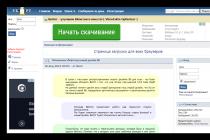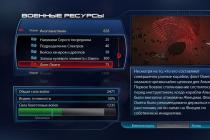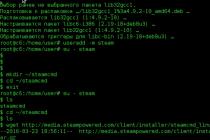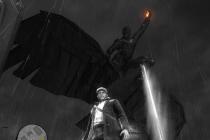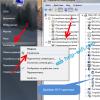In accordance with the requirements of the PUE, the volume of relay protection devices for power transmission lines is determined by the level of the rated voltage.
Lines 110 kV and above are made with a grounded neutral. For the 110-500 kV line, relay protection devices against multiphase and single-phase earth faults must be provided.
To protect against multiphase faults, distance protection is installed, and maintenance is installed as a backup.
Protection against SPC is performed using a residual current transformer and acts on the signal from the capacitive current.
Block BMRZ-KL
The purpose of the BMRZ-KL block.
The digital relay protection unit BMRZ-KL is designed to perform the functions of relay protection, automation, control, measurement and signaling of cable and overhead power lines, distribution substations and power plants, protection of electric motors. The function of determining the location of damage (OMP) has been implemented - calculating the distance in kilometers to the place of a two-phase or three-phase short circuit on power lines. The presence of branches on a multi-end line leads to an increase in the error of the OMP. The following parameters are used to calculate the distance to the short circuit location:
· Specific reactance of the line (Ohm / km), which is set by the consumer in the form of a setting when setting up BMRZ-KL;
· Values of the current and voltage of the short circuit loop, obtained from the oscillograms of the emergency process.
The current and voltage in the short-circuit loop is recorded in the section of the oscillogram with steady-state electrical values. If in the course of an accident a two-phase short circuit turns into a three-phase one, the average distances to the short circuit point are calculated. At the same time, the decrease in the reliability of the OMP result is reflected on the BMRZ-KL display in the form of the message "The result is unstable". The accuracy of calculating the distance to the fault location is proportional to the errors of the measuring current and voltage transformers and the accuracy of setting the parameters of the protected line. The OMP result does not depend on the transient resistance at the point of the short circuit. Inaccuracies in determining the parameters of the line have a much greater impact on the OMP. If OMP is impossible, for example, when protection is triggered without time delay, the distance to the place of damage is not displayed.
The BMRZ-KL block provides free assignment of reserve discrete inputs and outputs. The block implements two options for protection against SPL:
· Directional protection with zero sequence power direction control (analogue of ZZP - 1M and ZNZ);
· Registration of the effective value of the sum of higher harmonics in a current of 3 Iо (analogue of USZ-3M).
The second method is effective in networks with compensated neutral and can be used to automatically or manually disconnect a damaged feeder, drastically reducing the troubleshooting time. When combining the BMRZ-KL units in the ACS, information about the values of the higher harmonics 3Io in all feeders of the switchgear section appears on the computer of the relay operator or substation dispatcher in 1-2 seconds after the occurrence of the SPL.
The BMRZ-KL unit is produced in four versions, differing in the communication channel and in the voltage of the operating current.
Functions of the BMRZ-KL unit.
· Directional three-stage overcurrent protection (MTZ) with combined voltage start. For any stage, the settings are selected individually.
· Directional protection against single-phase earth faults (OZZ) with current and zero sequence voltage starting. Registration of higher harmonics of current 3Iо.
· Undervoltage protection (ZMN) with control of two line voltages and negative sequence voltage, with the possibility of blocking when starting the first and second stages of overcurrent protection.
· Protection against asymmetry and phase failure of the supply feeder (ZOF) with control of the negative sequence current, as well as I 2 / I 1.
· Redundancy in case of breaker failure.
· Automatic re-inclusion.
· Execution of commands of automatic frequency unloading and automatic reclosing by frequency.
· Automatic oscillography of alarm processes. (63 waveforms)
· Memory of emergency events.
· Counting of impulses from meters of active and reactive electricity (technical accounting).
· Measurement of network parameters.
· Self-diagnosis.
· Two programs of settings.
Distance protection BMRZ-LT
Three-stage distance protection (DZ) with a quadrangular actuation zone for all three stages (or a quadrangular actuation zone for the first two stages and a triangular for the third) is designed to protect overhead lines (overhead line block - transformer) from phase-to-phase short circuits without ground faults and is made with three relays resistances in each stage included on the AB, BC, CA circuits.
Four-stage residual current protection with definite time delays is intended for operation in case of single-phase and two-phase earth faults. The first three stages can be performed with a detuning from the magnetizing inrush current of the power transformer. Any stage can be configured by the user using the software keys:
Undirected;
Directional, with control of the zero sequence power direction release relay;
Directional, with control of the blocking relay of the direction of the zero sequence power;
Overcurrent protection
Three-stage overcurrent protection can be configured by the user using software keys: - non-directional; - directional with permission or blocking by the power direction relay signals; - with combined start-up by (U and U2) voltage; The stage of current protection with a phantom voltage start-up is designed for long-range redundancy in case of short-circuit on the low-voltage side behind the transformers and control of the successful self-starting of the remaining load after the short-circuit protection behind the transformer has been disconnected.
Phase loss protection
Unbalance and phase loss protection can be configured by the user using the software keys:
Undirected;
With reverse sequence power direction control;
With zero sequence power direction control.
Breaker failure redundancy (CBFP)
The "CBFP" signal is issued after a specified time after the signal is issued to open the circuit breaker while maintaining the current through the connection disconnected by the protection. The CBFP algorithm is performed with the control of the switch position. Time settings: from 0.10 to 1.00 s, step 0.01 s.
Automatic reclosing (AR)
The unit provides double automatic reclosure. The first and second automatic reclosure cycles can be disabled independently of each other using software keys. Automatic reclosure can be blocked when a cut-off is triggered and the presence of voltage 3Uo (ground in the network).
Multiphase protection
We use TO as the main protection.
Protection trip current
Relay operating current

Sensitivity factor

Therefore, the protection does not meet the sensitivity conditions
According to the PUE, step current protection should be installed on single lines with one-way power supply from multiphase faults. If such protections do not meet the requirements for sensitivity or speed of tripping, step distance protection shall be provided. In the latter case, it is recommended to use instantaneous overcurrent as additional protection.
Distance protection
Stage I
Find the response resistance of the 1st stage of protection
Line Resistance (90%)
Transformer resistance

Relay response resistance
II Stage
Line Resistance (10%)
Motor resistances:

where is the supertransient resistance, 0.2.
Protection response time
III Stage
Protection actuation resistance
Relay response resistance according to the formula (3.7)
Protection sensitivity coefficient as basic
Earth fault protection
Performed using TTNP
We find the capacitive current of the overhead line
Specific capacitive current of the AC 70 wire - 0.045A / km
Ground fault protection current
Earth fault current for overhead lines
Checking the sensitivity
Therefore, the protection meets the sensitivity conditions
Selection of the auxiliary power supply
We use storage batteries as a source of operating current, i.e. we use sources of direct operating current. The main advantage of which is independence from the mode of operation and the state of the primary network. Therefore, the DC auxiliary current is more reliable during a network outage.
Complain
Section 3. Protection and automation
Chapter 3.2. Relay protection
Protection of overhead lines in networks with a voltage of 110-500 kV with an effectively grounded neutral
3.2.106. For lines in 110-500 kV networks with an effectively grounded neutral, relay protection devices against multiphase faults and ground faults must be provided.
3.2.107. The protections must be equipped with devices that block their action during swinging, if swinging or asynchronous movement is possible in the network, in which excessive activation of the protection is likely. It is allowed to perform protection without blocking devices, if it is detuned from swinging in time (about 1.5-2 s).
3.2.108. For lines 330 kV and above, protection should be provided as the main one, acting without deceleration in case of short circuit at any point of the protected area.
For lines with a voltage of 110-220 kV, the question of the type of basic protection, including the need to apply protection acting without deceleration in the event of a short circuit at any point of the protected area, should be resolved first of all, taking into account the requirement to maintain the stability of the power system. In this case, if other, more stringent requirements are not imposed according to the calculations of the stability of the power system operation, it can be assumed that this requirement is usually satisfied when three-phase short-circuits, at which the residual voltage on the buses of power plants and substations is below 0.6-0, 7 U nom, turn off without time delay. The smaller value of the residual stress (0.6 U nom) can be allowed for 110 kV lines, less critical 220 kV lines (in highly branched networks, where consumers are reliably supplied with power from several sides), as well as for more critical 220 kV lines in cases where the considered short circuit does not lead to a significant discharge load.
When choosing the type of protection installed on 110-220 kV lines, in addition to the requirement to maintain the stability of the power system operation, the following should be taken into account:
1. On lines of 110 kV and higher, departing from the NPP, as well as on all elements of the adjacent network, on which, during multiphase short-circuits, the residual voltage of the positive sequence on the high-voltage side of the NPP units can decrease to more than 0.45 nominal, redundancy of high-speed protections with a time delay not exceeding 1.5 s, taking into account the action of the breaker failure protection.
2. Damages, the disconnection of which with a time delay can lead to disruption of the work of responsible consumers, must be disconnected without time delay (for example, damage in which the residual voltage on the buses of power plants and substations will be below 0.6 U nom, if turning them off with a time delay can lead to self-unloading due to a voltage avalanche, or damage with a residual voltage of 0.6 U nom and more, if turning them off with a time delay can lead to a violation of the technology).
3. If it is necessary to implement a high-speed automatic reclosure, a high-speed protection must be installed on the line, which ensures the disconnection of the damaged line without time delay on both sides.
4. When disconnecting with a time delay of faults with currents several times higher than the rated one, unacceptable overheating of the conductors is possible.
It is allowed to use high-speed protections in complex networks and in the absence of the above conditions, if it is necessary to ensure selectivity.
3.2.109. When assessing the provision of stability requirements, based on the residual stress values according to 3.2.108, it is necessary to be guided by the following:
1. For a single connection between power plants or power systems, the residual voltage specified in 3.2.108 must be checked on the buses of substations and power plants included in this connection, with a short circuit on the lines outgoing from these buses, except for the lines forming the connection; for a single connection containing part of the sections with parallel lines - also with a short circuit on each of these parallel lines.
2. If there are several connections between power plants or power systems, the value of the residual voltage specified in 3.2.108 should be checked on the buses of only those substations or power plants where these connections are connected, in case of short circuit on the connections and on other lines powered by these buses, as well as on lines powered by communication substation buses.
3. The residual voltage must be checked at a short circuit at the end of the zone covered by the first stage of protection in the mode of cascade fault tripping, that is, after the circuit breaker has been tripped from the opposite end of the line by the protection without time delay.
3.2.110. On single lines with one-way power supply from multiphase faults, step current protection or step current and voltage protection should be installed. If such protections do not meet the requirements for the sensitivity or speed of tripping the damage (see 3.2.108), for example, at the head sections, or if this is advisable under the condition of matching the protections of adjacent sections with the protection of the section in question, step distance protection should be provided. In the latter case, it is recommended to use instantaneous overcurrent as additional protection.
Against earth faults, as a rule, stepped current directional or non-directional zero sequence protection must be provided. The protection should be installed, as a rule, only on those sides from which the power can be supplied.
For lines consisting of several sequential sections, for the sake of simplicity, it is allowed to use non-selective step current and voltage protections (against multiphase faults) and step residual current protections (against ground faults) in combination with alternate automatic reclosure devices.
3.2.111. On single lines powered from two or more sides (the latter is on lines with branches), both in the presence and absence of bypass connections, as well as on lines included in a ring network with one power point, there must be distance protection is applied (mainly three-stage), used as a backup or main (the latter - only on 110-220 kV lines).
It is recommended to use instantaneous overcurrent as additional protection. In some cases, it is allowed to use a current cutoff for action in case of erroneous switching on a three-phase short-circuit at the place of protection installation, when the current cutoff, made for action in other modes, does not meet the sensitivity requirement (see 3.2.26).
Against earth faults, as a rule, stepped current directional or non-directional zero sequence protection must be provided.
3.2.112. As the main protection against multiphase faults at the receiving end of the head sections of the ring network with one supply point, it is recommended to use one-stage directional current protection; on other single lines (mainly 110 kV), it is allowed in some cases to use step current protection or step current and voltage protection, performing them, if necessary, directional. The protection should be installed, as a rule, only on those sides from which power can be supplied.
3.2.113. On parallel lines supplied from two or more sides, as well as on the supply end of parallel lines with one-way supply, the same protections may be used as on the corresponding single lines (see 3.2.110 and 3.2.111).
To accelerate the tripping of ground faults, and in some cases also faults between phases on lines with two-way power supply, additional protection with control of the direction of power in a parallel line can be applied. This protection can be performed in the form of a separate transverse current protection (with switching on the relay for zero sequence current or phase currents) or only in the form of an acceleration circuit of installed protections (zero sequence current, overcurrent, distance, etc.) with direction control power in parallel lines.
In order to increase the sensitivity of the zero sequence protection, it is allowed to provide for the deactivation of its individual stages when the switch of the parallel line is turned off.
Transverse directional differential protection should generally be provided at the receiving end of two parallel, one-way feed lines.
3.2.114. If the protection according to 3.2.113 does not meet the speed requirements (see 3.2.108), as the main protection (when two parallel lines are operating) at the supply end of two parallel 110-220 kV lines with one-way power supply and on two parallel 110 kV lines with bi-directional power supply mainly in distribution networks can be applied transverse differential directional protection.
In this case, in the operating mode of one line, as well as as a backup when operating two lines, protection according to 3.2.110 and 3.2.111 is used. It is allowed to turn on this protection or its individual stages for the sum of the currents of both lines (for example, the last stage of zero sequence current protection) in order to increase its sensitivity to damage on adjacent elements.
It is allowed to use transverse directional differential protection in addition to step current protection of 110 kV parallel lines to reduce the fault tripping time on the protected lines in cases where, according to the speed conditions (see 3.2.108), its use is not mandatory.
3.2.115. If the protection according to 3.2.111-3.2.113 does not meet the speed requirement (see 3.2.108), high-frequency and longitudinal differential protection should be provided as the main protection for single and parallel lines with two-way power supply.
For 110-220 kV lines, it is recommended to carry out basic protection using high-frequency blocking of distance and current directional zero sequence protections, when it is appropriate due to sensitivity conditions (for example, on lines with branches) or simplification of protection.
If it is necessary to lay a special cable, the use of longitudinal differential protection must be justified by a technical and economic calculation.
To control the serviceability of the auxiliary protection wires, special devices must be provided.
On 330-350 kV lines, in addition to high-frequency protection, it is necessary to provide for the use of a device for transmitting a disconnecting or enabling high-frequency signal (to accelerate the action of step-by-step backup protection), if this device is provided for other purposes. On 500 kV lines, it is allowed to install the specified device specifically for relay protection.
It is allowed in cases where it is required by the conditions of speed (see 3.2.108) or sensitivity (for example, on lines with branches), the use of the transmission of a disconnecting signal to accelerate the action of step protections of 110-220 kV lines.
3.2.116. When performing the main protection according to 3.2.115, the following should be used as backup:
- from multiphase short-circuits, as a rule, distance protection, mainly three-stage;
- from earth faults, stepped current directional or non-directional zero sequence protection.
In case of long-term deactivation of the main protection specified in 3.2.115, when this protection is installed at the request of the speed of fault clearing (see 3.2.108), it is allowed to provide for non-selective acceleration of the backup protection against short-circuits between phases (for example, with monitoring the voltage sequence).
3.2.117. The main protections, high-speed stages of backup protections against multiphase short-circuits and measuring devices of the OAPV device for 330-350 kV lines should be of a special design that ensures their normal operation (with the specified parameters) under conditions of intense transient electromagnetic processes and significant capacitive conductivity of the lines. For this, the following should be provided:
- in protection kits and measuring devices of OAPV - measures that limit the influence of transient electromagnetic processes (for example, low-frequency filters);
- in differential-phase high-frequency protection installed on lines longer than 150 km - devices for compensating currents caused by the capacitive conductivity of the line.
When switching on high-speed protections for the sum of currents of two or more current transformers, if it is impossible to meet the requirements of 3.2.29, it is recommended to provide for special measures to prevent unnecessary operation of protections in case of external faults (for example, coarsening of protections) or to install a separate set of current transformers in the line circuit to power the protection ...
In the protections installed on 330-500 kV lines equipped with longitudinal capacitive compensation devices, measures must be taken to prevent excessive operation of protection in case of external damage caused by the influence of these devices. For example, negative sequence power direction relays or enable signal transmission can be used. ¶ ×
annotation
Relay protection is the most important and most critical part of automation used in modern power systems. Relay protection studies the issues of automatic elimination of damages and abnormal modes.
Relay protection tasks, its role and importance in ensuring reliable operation of power systems and uninterrupted supply of electricity to consumers. This is due to the increasing complexity of circuits and the growth of power grids. In this regard, the requirements for the speed of action, selectivity, sensitivity and reliability of relay protection are increasing. Relay protection devices using semiconductor devices are becoming more widespread. Their use opens up more opportunities for creating fast-acting protections.
Currently, microprocessor-based relay protection devices are being developed, which will further increase the speed of protection.
Protected equipment parameters
Protected generator parameters.
There are designations:
T - turbine generator;
VF - hydrogen forced cooling;
63 - active power, MW;
2 - the number of rotor poles;
E - a single unified series;
U - climatic version - temperate climate;
Protected overhead line parameters.
Selection of 110 kV line protection
2.1 Line protection 110 kV W 5.
On single lines with one-way power supply in accordance with the PUE (clause 3.2.110), step current protection is provided:
1. From phase-to-phase short circuits. kit consisting of:
a) from current cutoff and overcurrent protection with a time delay (for dead-end lines)
2. An earth fault protection kit consisting of:
a) from zero sequence current cutoff and overcurrent protection with zero sequence time delay (for dead-end lines)
Calculation of 110 kV line protection.
3.1 Direct sequence equivalent circuit
The calculation is performed in named units at U base = 115 kV
Annex 1
System resistance:
Generator resistance:
Line resistance:
Resistance of transformers excluding voltage regulation
Resistance of transformers T1, T2 taking into account OLTC
TDTN – 40000/110/10
U rated nn = 11 kV
U к. M in = 9.52% = U к (-РО)
U c.nom = 10.5%
U to. M ax = 11.56% = U to (+ PO)
Resistance of the transformer T1, T2 at the extreme stage of "negative" regulation
where = 1-0.12 = 0.88
Resistance of the transformer T1, T2 at the 10th stage of "positive" regulation
where = 1 + 0.1 = 1.1
Resistance of the transformer T5
TDTN – 25000/110/10
U nom.vn = 115 kV ± 12% (± 12 steps)
U rated nn = 11 kV
U to (-PO) = 9.99%
U c.nom = 10.5%
U to (+ PO) = 11.86%
Resistance of transformer T5 at rated data
Resistance of the transformer T5 at the extreme stage of "negative" regulation
where = 1-0.12 = 0.88
Resistance of the transformer T5 at the 10th stage of "positive" regulation
where = 1 + 0.1 = 1.1
3.2 Zero-sequence equivalent circuit.
Selection of operating modes for neutrals of 110 kV transformers:
1. At the CHPP, the mode of solidly earthed neutrals T1 and T2 is adopted.
2. At the transit substation, we accept the mode: one transformer 25 MVA with a dead-grounded neutral, the second transformer - neutral is grounded through a spark gap (T3 and T4)
3. At a dead-end substation, the T5 transformer operates with a neutral grounded through an arrester.
When drawing up the circuit, the resistances of those elements through which the zero-sequence currents pass are taken into account (the circuit is presented in Appendix 2)
Appendix 2
System zero sequence resistance:
Resistance to zero sequence line:
K power lines = 3.0 for 2-chain lines with a ground wire
K power lines = 2.0 for single-circuit lines with a ground wire
Resistance of transformers
3.3 Calculation of short-circuit currents at points K 1, K 2, K 3 to select the setting of the overcurrent protection of the line W 5.
We collapse the equivalent circuit of the direct sequence reduced to points K3
![]()
Point K1
![]()
Point K2
X 21 = X res = X 20 + X 11 = 12.5 + 15 = 22.5 Ohm
![]()
Point K3
Normal mode:
X 22 = X res = X 21 + X 12 avg = 22.5 + 55.5 = 78 Ohm
![]()
Maximum mode:
X 22 = X res = X 21 + X 12 min = 22.5 + 74.4 = 96.9 Ohm
We select the KZ-9 set for stage I (TO) and select two sets of KZ-14 for the II and III stages of MTZ with time delays.
1st stage
The operating current I cf is selected from the condition of detuning from the current of a 3-phase short circuit at point K 3 in maximum mode.
We accept:
![]()
![]()
We select the RT 140/50 relay with a serial connection of the windings.
Sensitivity of the 1st stage with a 2-phase short circuit at the end of the line
![]()
![]()
t av = 0.1 sec - for detuning from t av arresters installed on the line.
2nd stage
The operating current I cf is selected from the condition of detuning from the maximum operating current of the protected line
![]()
K ot = 1.2 ÷ 1.3 - offset coefficient
K sz = 2 ÷ 3 - coefficient of self-starting of the electric motor
K car = 0.8 - coefficient of return of the relay RT-40 (RT-140)
![]()
![]()
Sensitivity of stage II to a 2-phase short circuit at point K 3 in minimum mode:
![]()
Likewise in normal mode
![]()
The response time is selected from the condition of coordination with the MTZ of the transformer on the 110 kV side
We accept:
Stage 3
The operating current I av is selected from the condition of ensuring K h ≥ 1.2 with a short circuit at point K 3 in maximum mode.
![]()
![]()
Choosing a RT-140/10 relay with parallel connection of windings
Choosing a time relay RV-132
![]()
3.4 Calculation of earth fault protection
We fold the zero-sequence equivalent circuit and determine the single-phase short-circuit currents at points K 1 and K 2 in different modes
| Maximum mode | Minimum mode |
| |
|
The equivalent circuit takes the form
| Maximum mode | Minimum mode |
 |  |
| For the short-circuit point K 1 | |
 |  |
| For the short-circuit point K 2 | |
| Short-circuit point K 1 | |
| | |
| Short-circuit point K 2 | |
| | |
We select the KZ-115 kit containing 3 current relays and two time relays. We do not use the zero sequence power direction relay.
3.5 Selecting the earth-fault current protection setting
Stage I
The operating current is selected according to the condition of ensuring the required sensitivity in case of an earth fault at the end of the line in the minimum mode (point K 2)
![]()
K 4 = 1.5 is the required sensitivity factor.
We accept
![]()
![]()
We choose the RT-140/50 relay with parallel connection of the windings.
II stage
The setting of the II stage is selected from the conditions of coordination with its I stage (protection redundancy)
![]()
We accept
![]()
We choose the RT-140/20 relay with parallel connection of the windings.
![]()
III stage
The setting of the III stage is chosen according to the condition of detuning from the maximum current of the unbalance flowing through the protection at a 3-phase short circuit behind the transformer (point K 3).
K ot = 1.25 - detuning factor
K lane = 1.0 - coefficient taking into account the increase in the unbalance current in the transient mode
K nb = 0.05 ÷ 1 - unbalance coefficient
I (3) = 852 (A) - rated short-circuit current
I nom.tr-ra = 125 (A)
We accept
![]()
We select the RT-140/10 relay with parallel connection of the windings.
![]()
8.1. What types of protection are used on 110-220 kV overhead lines?
Networks, as a rule, operate with solidly grounded neutrals. Therefore, protections are performed both against polyphase (with the exception of double earth faults at different points) and against single-phase short circuits. Networks are often complex configurations with multiple power supplies. Therefore, for protection against multiphase short circuits (including double earth faults at one point), distance step protections with different characteristics of resistance elements are often used, equipped with interlocks against swinging and violations of secondary circuits. It is not distance protection that is used against earth faults, but current multistage directional zero sequence protection.
In cases when, according to the conditions of ensuring the stability of the system and responsible consumers, protection action is required along the entire length of the protected section without time delay (on the buses of stations and nodal substations Uost at a 3-phase short circuit ≤ 0.6 ÷ 0.7 Unom), two solution of the issue: addition of step protections with HF blocking devices or transmission of tripping signals and use as the main separate longitudinal protection with absolute selectivity. The preference is given to the second option, which provides independence in operation and more perfect short-range redundancy.
Sometimes it is possible to use simpler current step protections on dead-end lines.
8.2. What are called distance protections?
Remote are called protections with relative selectivity, performed using measuring resistance devices - organs, the characteristic value for which, according to GOST, is a given function of the ratios of the acting voltages to the acting currents expressed in a complex form.
In practice, the operation of distance protections during short-circuit is determined not only by the distance to the place of damage, but also by a number of other distorting factors - transition resistances, the presence of power supplies and loads between the places of their switching on and short-circuit, phase shifts between the EMF of power supplies, a non-optimal combination of the influencing values of the resistance organs etc..
8.3. Name the types of panels used to protect 110-220 kV overhead lines.
Currently, electromechanical, semiconductor and microprocessor types of protection panels are used. These include panels discontinued but still in operation: PZ-157, PZ-158, PZ-152, PZ-153, PZ-164A, PZ-2, PZ-201, DFZ-2,
Industrial EPZ-1636; ShDE-2801 (2); PDE-2802; DFZ-201; EPZ 1637-91 (for performing transverse differential current directional protection of parallel power lines); EPZ 1639 91 (to perform longitudinal differential current protection of the 1st or 2nd transmission lines); EPZ 1643 (HF blocking of DZ and ground faults); ShDE 2803 (DZ and current protection of lines with sets of breaker protection devices); ШЭ2607 011021 (line protection and control cabinet for linear circuit breaker); ShE2607 031 (directional line protection with HF blocking); ШЭ2607 081 (differential-phase line protection). Cabinets of the ШЭ2607 series are made on microprocessor terminals of the BE2704 series.
8.4. How are the stages of residual earth fault protection selected for single 1110-500 kV lines with two-way power supply without branches?
According to the RH Guideline No. 12 operating current of the first stage when it is performed without time delay, it is selected according to the conditions of detuning from the triple zero-sequence current passing at the place of protection installation:
When there is a ground fault on the buses of the opposite substation;
In a short-term incomplete-phase mode, which occurs when the phases of the circuit breaker are switched on simultaneously;
In the open-phase mode that occurs in the OAPV cycle on the protected line.
Second stage operating current protection is selected according to the conditions:
Detuning from the triple zero sequence current passing at the place of installation of the protection in case of a ground fault behind the previous autotransformer on the side of its adjacent voltage;
Detuning from the triple zero sequence current passing at the place of protection installation in the open-phase mode, arising in the OAPV cycle on the protected or previous line, as well as in the long-term open-phase mode on the previous line.
The second stage usually protects the entire line and operates with a time delay of 0.4-0.5 s.
Operate current of the third stage is selected according to the condition of matching with the protection of the previous line (with its second or third stage) or protection against ground faults of the previous autotransformer installed on the side of the adjacent voltage.
Actuation current of the fourth stage must be isolated from the current in case of external faults between phases, if the considered zero sequence protection stage has a time delay equal to or less than the protection against short-circuits between phases on the damaged element.
The third and fourth stages reserve the 1st and 2nd and carry out the functions of long-range redundancy. Their actuation (except for those accelerated when turned on) gives grounds to assume the presence of a malfunction in the circuits of the 1st or 2nd stages, and a failure of the switch or protections on the adjacent element is also possible.
The 3rd and 4th stages, as the most sensitive ones, can be triggered in an incomplete-phase mode. In this case, it is allowed to display the triggered steps. In most cases, it is not possible to ensure selectivity in open-phase operation.
The tasks of relay protection, its role and purpose are to ensure the reliable operation of power systems and the uninterrupted supply of electricity to consumers. This is due to the complication of schemes and the growth of power grids, the enlargement of power systems, an increase in the installed capacity of both stations as a whole and the nominal unit capacity of individual units. This, in turn, affects the operation of power systems: work at the stability limit, the presence of long intersystem communication lines, an increased likelihood of chain accidents. In this regard, the requirements for speed, selectivity, sensitivity and reliability of relay protection are increasing. Relay protection devices using semiconductor devices are becoming more and more widespread. Their use opens up more opportunities for creating fast-acting protections.Currently, microprocessor-based relay protection devices have been developed and are beginning to be actively used, which makes it possible to further increase the speed and reliability of protections, and reduce the cost of their repair and maintenance.
1.2.2 The parameters of the transformer are summarized in Table 2.
TABLE 1.2
SELECTION OF TYPES OF RELAY PROTECTION DEVICES
Relay protection of overhead line 110 kV.
| Rev. |
| Sheet |
| Document no. |
| Sheet |
| Document no. |
| Signature |
| date |
| Sheet |
| KP.140408.43.06.PZ |
| Rev. |
| Sheet |
| Document no. |
| Signature |
| date |
| Sheet |
| KP.140408.43.06.PZ |
3.1 Calculation of direct sequence resistances of circuit elements.
Resistances are calculated in named units (Ohms), with a base voltage Ub = 115 kV.
The equivalent circuit is shown in Fig.
C1: X 1 = X * s * = 1.3 * = 9.55 Ohm
X 2 = X beats. * l * = 0.4 * 70 * = 28 Ohm
X 3 = X beats. * l * = 0.4 * 45 * = 18 Ohm
X 4 = X beats. * l * = 0.4 * 30 * = 12 Ohm
X 5 = X beats. * l * = 0.4 * 16 * = 6.4 Ohm
T 6 = * = * = 34.72 Ohm
T 7 = * = * = 220.4 Ohm
X 3.4 = 18 + 12 = 30 Ohm
| Rev. |
| Sheet |
| Document no. |
| Signature |
| date |
| Sheet |
| KP.140408.43.06.PZ |
X 2.4 = = 14.48 Ohm
X 1-4 = 9.55 + 14.48 = 24.03 Ohm
X 1-5 = 24.03 + 6.4 = 30.34
| Rev. |
| Sheet |
| Document no. |
| Signature |
| date |
| Sheet |
| KP.140408.43.06.PZ |
I (3) (k 2) = = = 2.18 kA
I (3) (k 3) = = = 0.26 kA
3.2 Calculation of single-phase short-circuit currents to earth at point K-2.
C1: X 1 = X * s * = 1.6 * = 11.76 Ohm
X 2 = X beats. * l * = 0.8 * 70 * = 56 Ohm
X 3 = X beats. * l * = 0.8 * 45 * = 36 Ohm
X 4 = X beats. * l * = 0.8 * 30 * = 24 Ohm
X 5 = X beats. * l * = 0.8 * 16 * = 12.8 Ohm
X 3.4 = 36 + 24 = 60 Ohm
| Rev. |
| Sheet |
| Document no. |
| Signature |
| date |
| Sheet |
| KP.140408.43.06.PZ |
X 2,3,4 = (60 * 56) / (60 + 56) = 28.97 Ohm
X 1-4 = 11.76 + 28.97 Ohm
| Rev. |
| Sheet |
| Document no. |
| Signature |
| date |
| Sheet |
| KP.140408.43.06.PZ |
X 1-6 = 18.74 + 12.8 = 31.54 Ohm
X res. 0 (k2) = 31.54 Ohm
3I 0 (k2) = = = 2.16 kA
3.6 Calculation of short-circuit currents at points K-4 and K-5.
| Ub = Umin = 96.6 kV | Ub = Umax = 126 kV | ||||||||||||||||||||||||||||||||||||||||||||||||||||||||||||||||||||||||||||||||||||||||||||||||||||||||||||||||||||
| X 10 = X c1.2 = X c1.2 sr. * = 24.03 * = 16.96 Ohm | X 10 = X c1.2 = X c1.2 sr. * = 24.03 * = 28.85 Ohm | ||||||||||||||||||||||||||||||||||||||||||||||||||||||||||||||||||||||||||||||||||||||||||||||||||||||||||||||||||||
| Xc = Xc cf * = = 16.96 Ohm | Xc = Xc cf * = = 28.85 Ohm | ||||||||||||||||||||||||||||||||||||||||||||||||||||||||||||||||||||||||||||||||||||||||||||||||||||||||||||||||||||
| X T (-PO) = * = = 41.99 | U to (+ N) = U to number. + = 17.5 + = 18.4 Xt (+ N) = * * = 71.44 Ohm | ||||||||||||||||||||||||||||||||||||||||||||||||||||||||||||||||||||||||||||||||||||||||||||||||||||||||||||||||||||
| Z nw = 0.3 * 1.5 * = 38.01 Ohm | Z nw = 0.3 * 1.5 * = 64.8 Ohm | ||||||||||||||||||||||||||||||||||||||||||||||||||||||||||||||||||||||||||||||||||||||||||||||||||||||||||||||||||||
| Point K-4 | |||||||||||||||||||||||||||||||||||||||||||||||||||||||||||||||||||||||||||||||||||||||||||||||||||||||||||||||||||||
| Xrez (k4) = Xc + Xtv (-po) = 16.96 + 41.99 = 58.95 Ohm | Xrez (k4) = Xc + Xtv (+ N) = 28.85 + 71.44 = 100.29 Ohm | ||||||||||||||||||||||||||||||||||||||||||||||||||||||||||||||||||||||||||||||||||||||||||||||||||||||||||||||||||||
| I (3) max = = 0.95kA | I (3) by max = = 0.73 kA | ||||||||||||||||||||||||||||||||||||||||||||||||||||||||||||||||||||||||||||||||||||||||||||||||||||||||||||||||||||
| The actual value of the short-circuit current at point K-4, referred to a voltage of 37 kV | |||||||||||||||||||||||||||||||||||||||||||||||||||||||||||||||||||||||||||||||||||||||||||||||||||||||||||||||||||||
| I (3) max = 0.95 * = 8.74 kA | I (3) max = 0.73 * = 8.76 kA | ||||||||||||||||||||||||||||||||||||||||||||||||||||||||||||||||||||||||||||||||||||||||||||||||||||||||||||||||||||
| Point K-5 | |||||||||||||||||||||||||||||||||||||||||||||||||||||||||||||||||||||||||||||||||||||||||||||||||||||||||||||||||||||
4.1 Line protection with one-way power supply. 4.1.1 Calculation of two-stage current protection against phase-to-phase short-circuits of line W. Calculation of the current cutoff without time delay from phase-to-phase faults (Istage). 1) I 1 sz Kots. * I (3) k-3max = 1.2 * 0.26 = 0.31 kA 2) Kp = I (2) k-1min / Ic.z. 1 = 2.76 * 0.87 / 0.31 = 7.74 Kch = I (2) k-2min / Ic.z. 1 1.5 = 2.18 * 0.87 / 0.31 = 6.12 3) I (1) s.r. = I (1) cs * Ksh / K1 = 0.31 * 1 / (100/5) = 0.02 kA 4) The response time of the current cutoff is taken as 0.1 s Calculation of overcurrent protection with time delay from phase-to-phase short-circuits (stage II). 1) I II sz Coots * Ksz / Kv) * Iload.max = (1.2 * 2 / 0.8) * 0.03 = 0.09kA Iload.max = Snom.t. / = 6.3 / = 0.03 kA 2) Kch = I (2) k-3min / Ic.z. I 1 1.2 = 0.26 * 0.87 / 0.09 = 2.51 3) I (11) s.r. = I (11) cs * Ksx / K1 = 0.09 * 1 / (100/5) = 0.0045 kA 4) The response time of the MTZ is selected according to the condition of agreement with the MTZ tr-ra. t II sz = tsz (mtz t-raT) + t = 2 + 0.4 = 2.4 s 4.1.2. Calculation of two-stage earth-fault current protection for line W. Calculation of zero sequence cutoff currents without time delay (1 step). 1) I (1) 0cz 3I0 (1) k-2min / Kch = 2.16 / 1.5 = 1.44 kA 2) I (1) 0cr I0 (1) ss * Ksh / K I = 1.44 * 1 / (100/5) = 0.072 kA 3) The response time of the current cutoff is taken equal to 0.1 s. Calculation of zero sequence current protection with time delay (stage 2). 1) I 11 0cz Kots * Inb.max = Kots * Kper * Knb * Icalculated = 1.25 * 1 * 0.05 * 0.26 = 0.02 kA I accept I 11 0cz = 60A 4.2 Calculation of transformer protection.
The setpoint must be selected from two conditions: - detuning from the inrush current of the magnetizing of the power transformer. - detuning from the maximum primary unbalance current in the transient mode of the calculated external short circuit. Detuning from inrush current of magnetizing. When the power transformer is turned on from the high voltage side, the ratio of the inrush current of the magnetizing to the amplitude of the rated current of the protected transformer does not exceed 5. This corresponds to the ratio of the amplitude of the inrush current of the magnetizing current to the effective value of the rated current of the first harmonic equal to 5 = 7. The cut-off reacts to the instantaneous value, equal to 2.5 * Idif. / Inom. The minimum possible setting for the first harmonic is Idif / Inom = 4, which contributes to 2.5 * 4 = 10 in relation to the amplitudes. Comparison of the obtained values testifies to the detuning of the cutoff in instantaneous values from the possible inrush of the magnetizing current. Calculations show that the effective value of the first harmonic of the magnetizing current inrush does not exceed 0.35 of the inrush amplitude. If the amplitude is 7 rms values of the rated current, then the rms value of the first harmonic is 7 * 0.35 = 2.46. Therefore, even with a minimum setting of 4 Inom. The cut-off is detuned from the magnetizing current inrush and when regulating to the first harmonic of the differential current. Detuning from unbalance current at external short circuit.
Idif / Inom Kots * Knb (1) * Isc.vn.max where Кнб (1) is the ratio of the amplitude of the first harmonic of the unbalance current to the reduced amplitude of the periodic component of the external short circuit current. If a CT with a secondary rated current of 5A is used on both the HV and LV side, it is possible to take Knb (1) = 0.7. If a CT with a secondary rated current of 1A is used on the HV side, then Knb (1) = 1.0 should be taken. The detuning factor (Coots) is assumed to be 1.2. Isc.vn.max-ratio of the external rated short-circuit current to the rated current of the transformer. If a through current Irms passes through the protected transformer, it can be a differential current. Idif. = (Kper * Code * E + Urpn + fadd.) * I well = (2 * 1.0 + 0.13 + 0.04) * I well = 0.37 * I well. When deriving this formula, it was assumed that one TT works accurately, the second has an error equal to Idif. Let's introduce the concept of the brake current reduction factor. Ksn.t. = Istorm. / Iscv. = 1-0.5 * (Kper * Code * E + Uрпн + fadd) / Ксн.т. = 100*1.3* (2 * 1 * 0.1 + 0.13 + 0.04) / 0.815 = 59 The second breakpoint of the braking characteristic: It 2 / Inom determines the size of the second section of the braking characteristic. In load and similar modes, the braking current is equal to the through current. The appearance of the orbit faults only slightly changes the primary currents, so the braking current has hardly changed. For high sensitivity to orbit short-circuits, it follows that the mode of rated loads, (Im / Inom = 1), the mode of permissible long-term overloads (Im / Inom = 1.3) falls into the second section. It is desirable that the second section also includes the modes of possible short-term overloads (self-starting of motors after ATS, starting currents of powerful motors, if any).
I accept I g2 / I g1 = 0.15 We calculate the sensitivity coefficient for the considered network. Primary current of protection operation in the absence of braking: Ic.z = Inom * (I 1 / Inom) = 208 * 0.3 = 62.4 A. When checking the protection sensitivity, we take into account that due to the direction of braking at internal short-circuits, there is no braking current. Sensitivity for two-phase short circuit on the LV side CV = 730 * 0.87 / 62.4 = 10.18 Conclusion: the sensitivity is sufficient. 4.3 Overload protection "Sirius-T". The overload signal setting is assumed to be: Isz = Kots * Inom / Kv = 1.05 * 3.4 / 0.95 = 3.76, where the detuning factor Coots = 1.05; the return coefficient in this device is Kv = 0.95. It is recommended to determine the rated current Inom taking into account the possibility of increasing it by 5% when regulating the voltage. For a 40 MVA transformer, the rated secondary currents on the middle branch on the HV and LV sides are 3.4 and 3.5 A. The calculated values of the load setting are equal. HV side: Ivn = 1.05 * 1.05 * 3.4 / 0.95 = 3.95 A LV side: Inn = 1.05 * 1.05 * 3.5 / 0.95 = 4.06 A If the transformer has a split LV winding, then overload control must be carried out by bushing protection devices installed on the LV side circuit breakers. The protection operates on tires with tsz = 6s.
The calculation of the operation parameters (settings) of the maximum current protection consists in the selection of the protection operation current (primary); relay actuation current. In addition, a computational check of the current transformer is carried out. Selection of the operating current. The settings for the current of overcurrent protection must ensure the failure of the protection for tripping in case of successive overloads and the necessary sensitivity for all types of short-circuits in the main zone and in the redundancy zone. Iсз = Ксз * Ксх / Ктт = 265 * 1 / (300/5) = 4.42 A Checking the sensitivity of the overcurrent protection. Kch I (3) k.min.vn / Isz = 0.87 * 730/265 = 2.4 Kch I (3) k.min.vn / Isc = 0.87 * 5.28 / 265 = 1.73 1.2
Isc.nn = Isc.vn * Uvn / Unn = 730 * (96.58 / 10) = 7050 A Voltage start. Calculation of maximum overcurrent protection with combined voltage starting installed on the 10.5 kV side. The primary voltage of the protection operation for the undervoltage relay under the condition of detuning from the self-starting voltage when switched on from the automatic reclosing or autoreclosing of the braked load motors and on the condition of ensuring the return of the relay after the external short circuit is disconnected is taken: Usc = 0.6Unom = 0.6 * 10500 = 6300V In this case, the operating voltage of the undervoltage relay will be: Uav = Usz / Kch = 0.6 * 10500 / (10500/100) = 60 V. The RN-54/160 relay is accepted for installation For a filter relay, the reverse voltage sequence of the protection operation voltage is taken according to the condition of unbalance voltage detuning in the load mode. U2sz 0.06 * Unom = 0.06 * 10500 = 630V Voltage of operation of the filter-relay voltage of the negative sequence. U2av = U2sz / K U = 630 / (10500/100) = 6V It is taken to the setting of the RSN-13 filter relay. Checking the voltage sensitivity at short-circuit at point-5-for the undervoltage relay. KchU = Usz * Kv / Uz.max = 6.3 * 1.2 / 4.1 = 1.84 1.2 where Uz.max = 3 * I (3) k-4max * Zkw.min = * 5280 * 0.45 = 4.1kV here I (3) k-4max is the three-phase short-circuit current at the end of the cable line in the maximum operating mode (mode 9) - for the reverse sequence voltage relay filter.
where U2z.min = 0.5 * Unom.nn.- * I 2 max * Zkw.min = 0.5 * 10.5- (2) * 0.3 * 1.5 = 5.25-2.05 = 3.2kV here I 2 max is the negative sequence current at the protection installation site in case of a fault between two phases at the end of the cable line in the maximum operating mode. You can take: I 2 max = I (3) k-4.max / 2 = I (2) k-4.max / 2 The selection of protection time delays is made according to the stepwise principle. tsz mtz-10 = tsz.sv-10 + t = 1 + 0.5 = 1.5s (RV-128) tsz mtz-110 = tsz.mtz-35 + t = 2.3 + 0.3 = 2.6 (RV-0.1) where tsz.sv-10 is the protection operation time on the 10 kV sectional switch The degree of selectivity t is adopted for the time relay RV-0.1 t = 0.3 s, for the time relay RV-128 t = 0.5 s.
6.Calculation of 10 percent error of current transformers TFND-110. Transformation ratio = 100/5 Estimated multiplicity of 10 percent error: K (10) calc. = 1.1 * Ic / I1nom. = 1.1 * 1440/100 = 15.84 the 10% error curve is used to determine the permissible secondary load Z2adm. Z2add. = 2 Ohm Z2add. = Zp + Rpr + R 0.05 trans. Zp = 0.25Ω Z2add. = Zp + Rпр + Rпр. Rpr = 2-0.25-0.05 = 1.7 Ohm q = * l / Rpr = 0.0285 * 70 / 1.7 = 1.17 |

